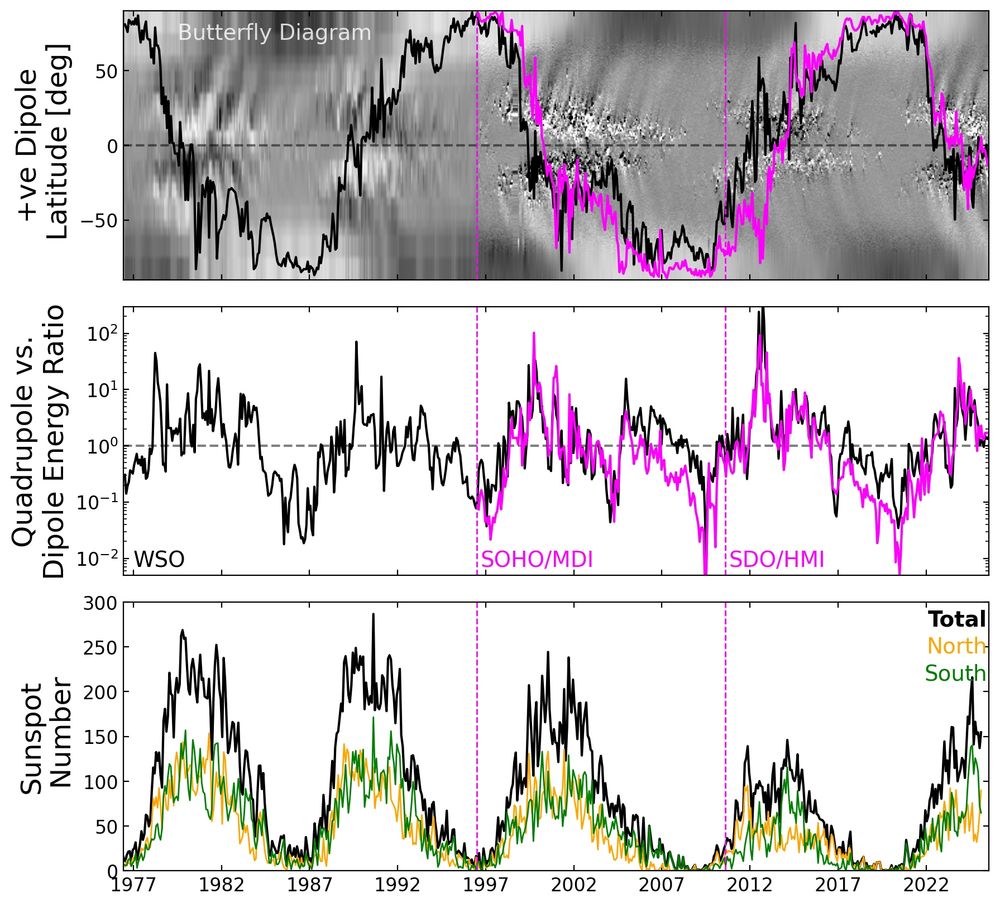
The magnetic energy in the quadrupole (l=2) and dipole (l=1) are now pretty comparable which may be why the solar corona is looking so dipolar. The octupole (l=3) is often in synch with the dipole and so the quadrupole is the main competitor when it comes to the large-scale structure.
04.08.2025 14:12 — 👍 2 🔁 0 💬 0 📌 0
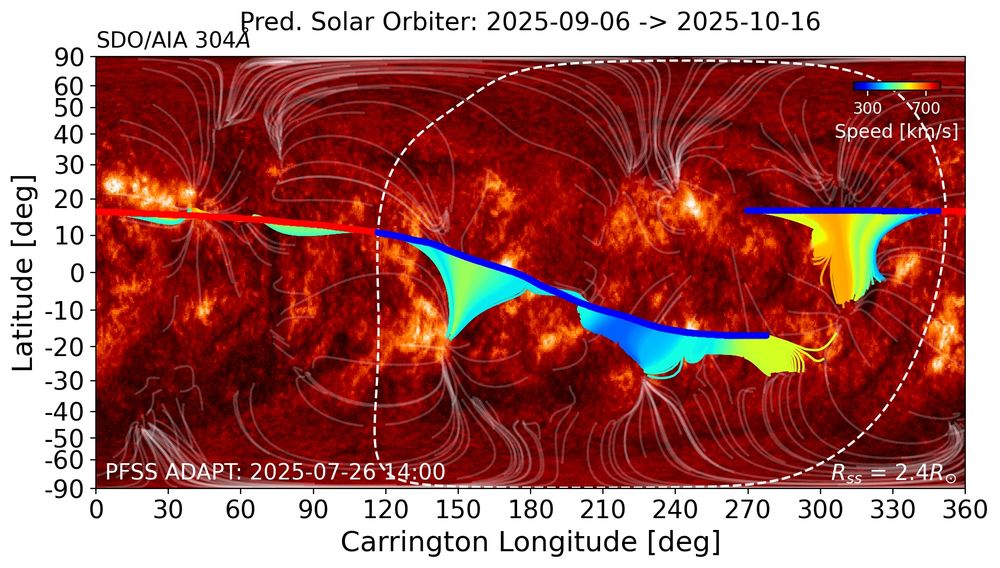
Two crossings of the coronal hole at the negative dipole axis at 310 Carrington longitude. Closest approach in the south above the coronal hole at 180 degree (which may have closed by then). And a scan across the nested active regions at (-15,120) and (15,20), if they stay active until September..
28.07.2025 08:56 — 👍 2 🔁 0 💬 0 📌 0
Here's the same process applied to the Autumn 2025 remote-sensing window:
28.07.2025 08:56 — 👍 2 🔁 0 💬 1 📌 0
Here's a comparison of the coronal magnetic field from solar minimum (Dec 2019) and now at solar maximum. The dipole component of the Sun's magnetic field is visibly inclined to the rotation axis.
27.07.2025 14:52 — 👍 0 🔁 0 💬 1 📌 0
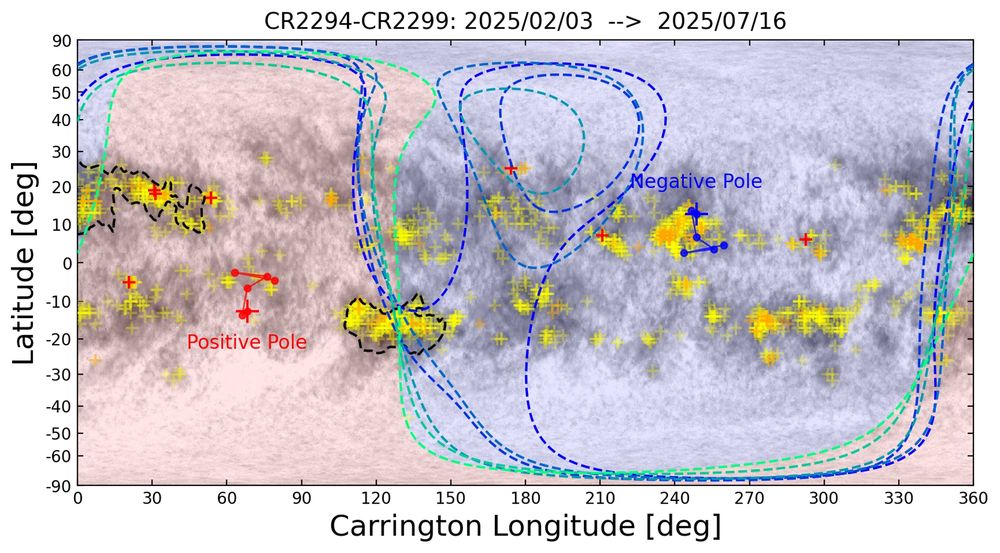
You can see the stability of the positive-negative sectors over the last five rotations, with two nested active regions (black contours) helping to restrict the heliospheric current sheet. GOES flares are shown with coloured markers. The dipole axis has just started to move away from the equator.
27.07.2025 14:52 — 👍 0 🔁 0 💬 1 📌 0
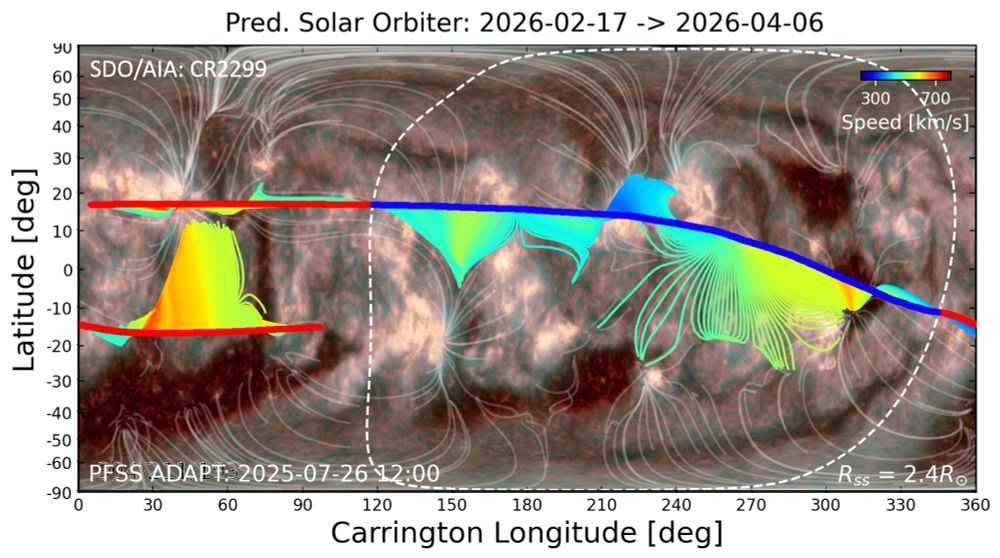
At present, the Sun's large-scale magnetic field is well-described by an inclined dipole, with coronal holes near the positive and negative dipole axis. This has been the case for a year now. Solar Orbiter's path would cut across a large positive coronal hole twice around 60 degrees Car. longitude.
27.07.2025 14:52 — 👍 0 🔁 0 💬 1 📌 0
What might we expect to see during @esa.int Solar Orbiter's upcoming remote-sensing windows; now with an inclined orbit. Here's the PFSS connectivity of Orbiter during the remote-sensing window of spring 2026 (17th Feb to 6th March), using the current coronal magnetic field and in-situ wind speeds.
27.07.2025 14:52 — 👍 7 🔁 3 💬 2 📌 0
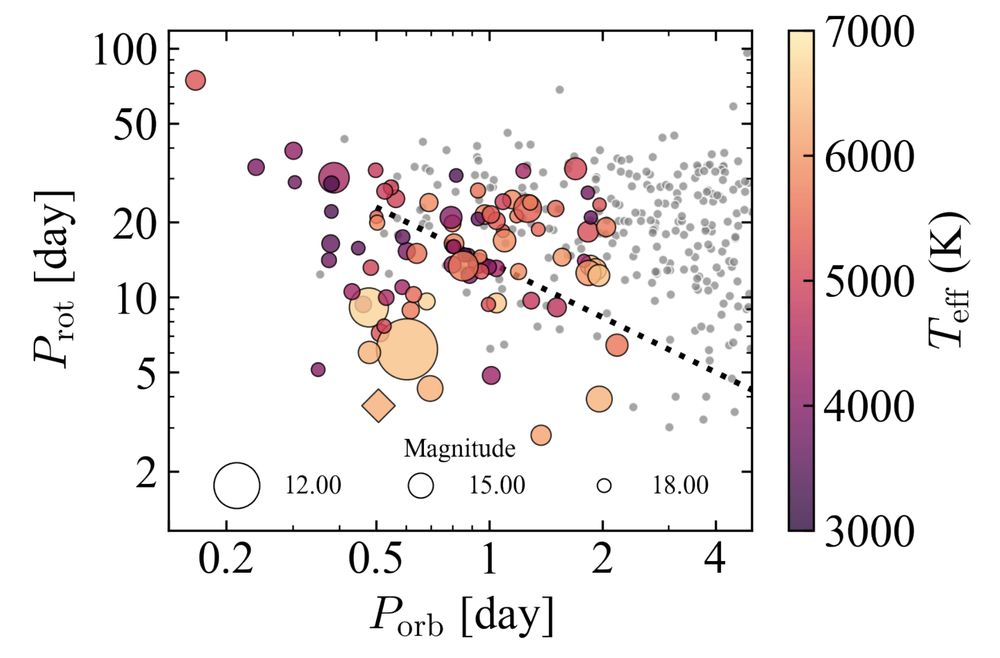
It's paper time !
It was published on A&A a few days ago, we have been looking for possible super-close non-transiting exoplanets in the Kepler data 🪐⭐
www.aanda.org/articles/aa/...
25.07.2025 15:25 — 👍 1 🔁 1 💬 1 📌 0
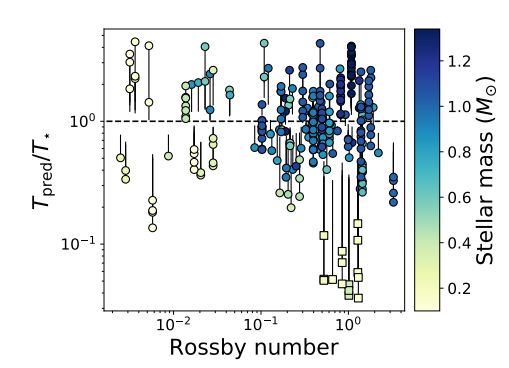
The effect this has on the spin-down of fully-convective stars was explored using the stellar wind braking torques from Finley & Matt 2018. The ratio of the torque calculated for each ZDi map versus the activity-Rossby relation shows they can be underestimated by an order of magnitude or more. (4/4)
24.07.2025 08:36 — 👍 1 🔁 0 💬 0 📌 0
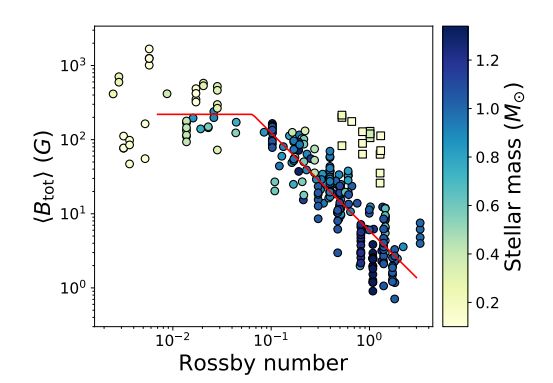
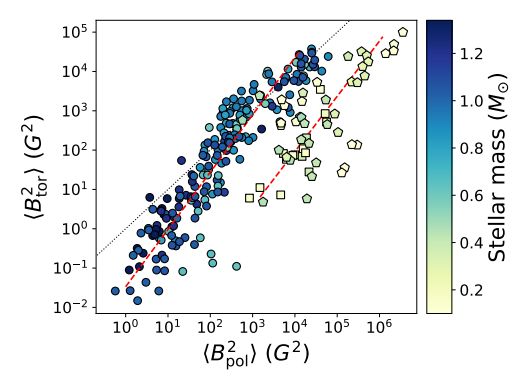
The magnetic fields of slowly rotating fully-convective stars, shown as square markers, diverge from the activity-Rossby (rotation/turnover) relation of Sun-like stars. The stronger magnetic field strengths suggest different mechanisms are at work in partially- vs fully-convective stars. (3/4)
24.07.2025 08:36 — 👍 0 🔁 0 💬 1 📌 0
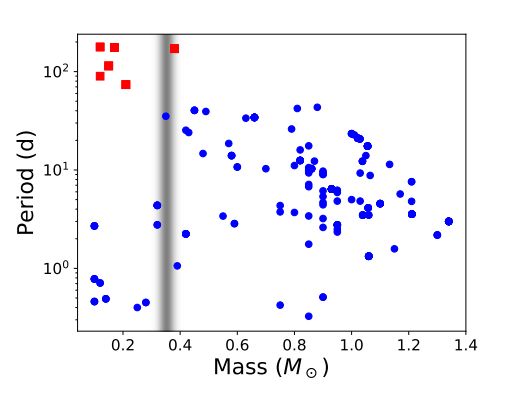
Slowly rotating low-mass stars are challenging to observe with the ZDi technique, so we previously lacked the information to constrain the properties of the fully-convective dynamos in these stars. This work now includes this stars, shown in red, in the sample of 96 stars. (2/4)
24.07.2025 08:36 — 👍 0 🔁 0 💬 1 📌 0
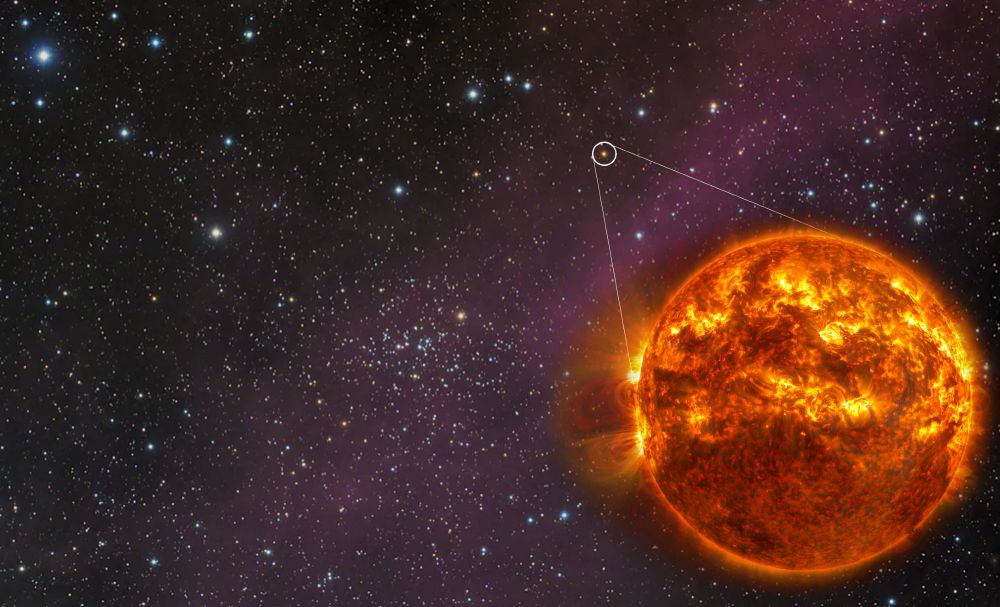
New paper day! See et al. explores how the large-scale magnetic fields of low-mass stars (0.2-1.3 solar mass) vary as a function of stellar rotation and convective turnover time. Victor focuses on the latest Zeeman-Doppler imaging of slowly rotating M-dwarfs. arxiv.org/pdf/2507.16986 (1/4)
24.07.2025 08:36 — 👍 4 🔁 1 💬 1 📌 0
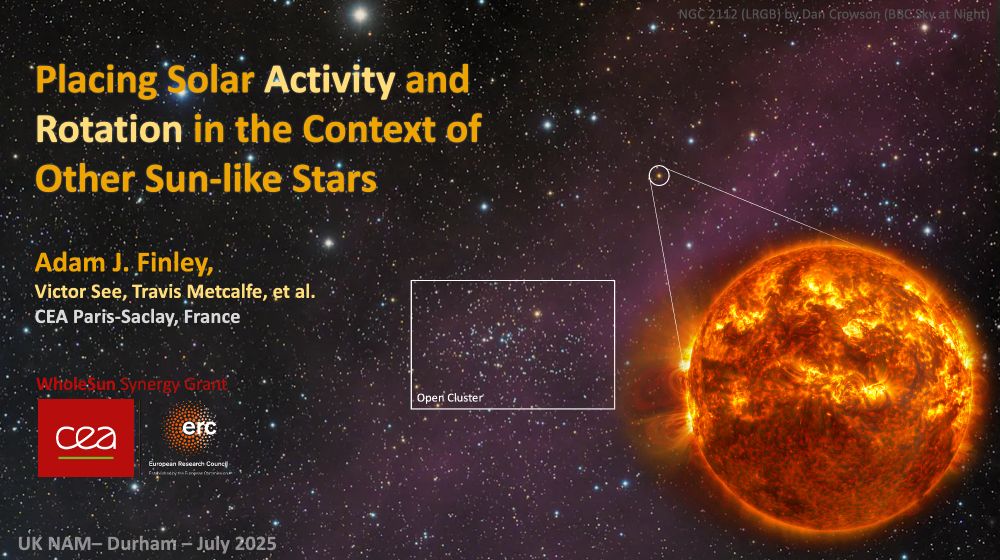
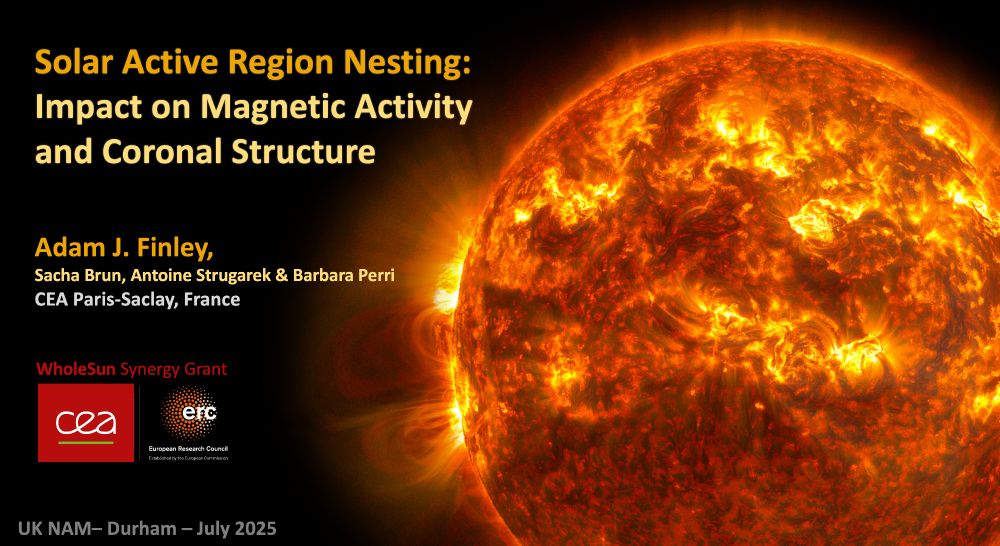
Today: 14.40 Nested Active Regions! UK SolPhys Open Session conference.astro.dur.ac.uk/event/7/sess...
Tomorrow: 09.00 Activity and Rotation of Sun-like stars! Common Nature of Solar/Stellar Coronae conference.astro.dur.ac.uk/event/7/sess...
@nam25-durham.bsky.social #NAM2025 #NAM2025durham
08.07.2025 09:33 — 👍 2 🔁 0 💬 0 📌 0
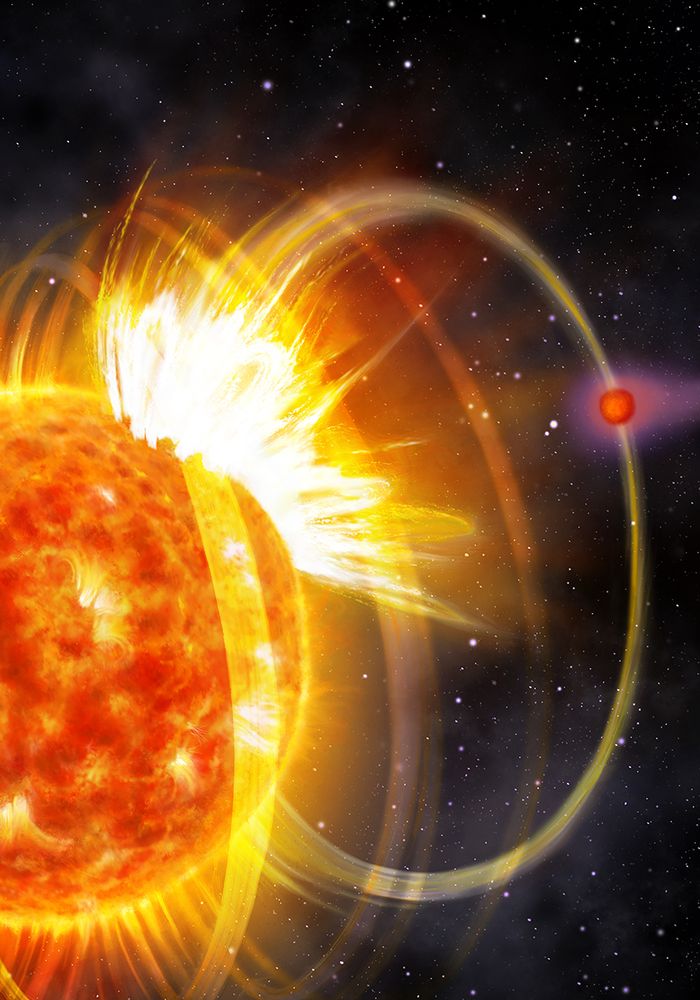
A bright, fiery, orange-yellow star with swooping magnetic field lines, releasing an intense flare of light into space. To the right of the star, there is a small red planet touching one of the star's magnetic field lines. The flare is blasting in the direction of the planet. A haze of gas around the planet seems to be being pushed out into space. The background is filled with stars, giving the impression of deep space.
🆕For the first time, astronomers using our Cheops mission have caught a planet triggering flares of radiation from the star it orbits 🪐💥
These tremendous explosions are blasting away the planet’s wispy atmosphere, causing it to shrink every year.
Find out more 👉 www.esa.int/Science_Expl...
🔭 🧪
02.07.2025 15:11 — 👍 151 🔁 28 💬 3 📌 7
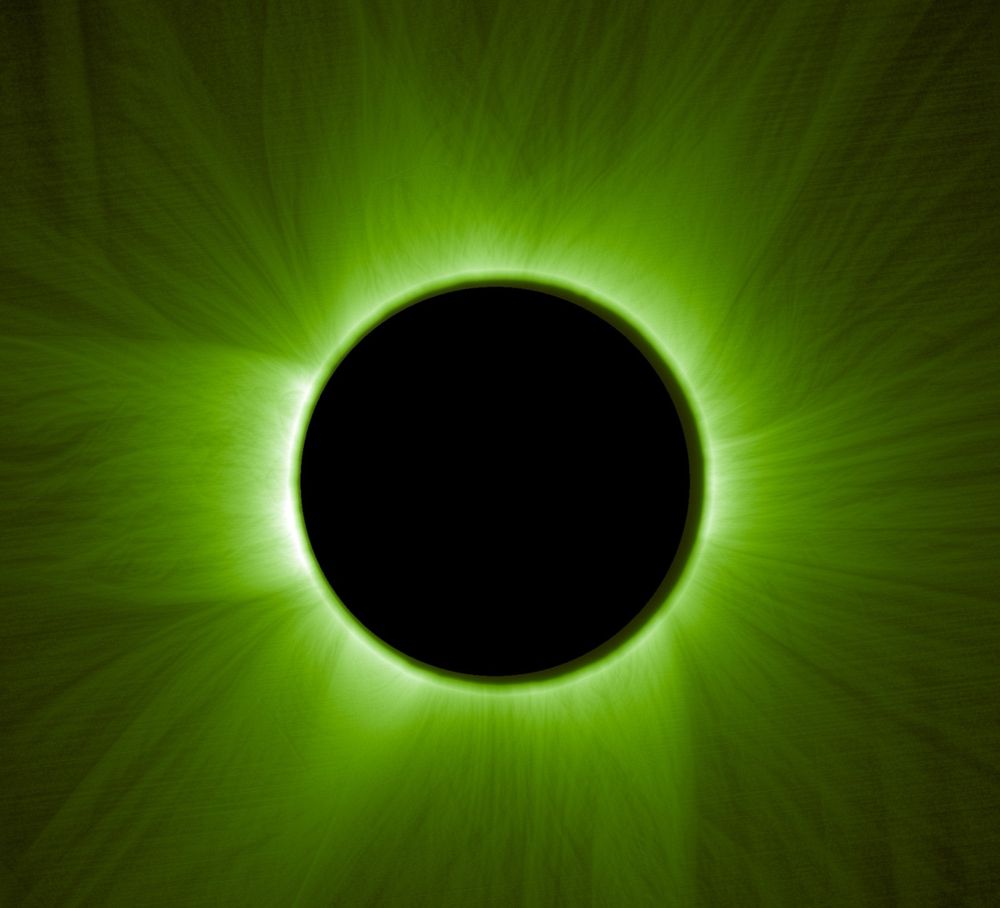
Breaking space news: We have made our own solar eclipse in space! 🌘
Today, we release the first images from our Proba-3 mission, which flies two spacecraft in precise formation to create artificial solar eclipses in orbit.
Learn more ➡️ www.esa.int/Enabling_Sup...
16.06.2025 14:30 — 👍 456 🔁 106 💬 9 📌 25
Ready to see the Sun like we never have before? 😎
#SolarOrbiter has just released the first views ever of the Sun’s poles!
Thanks to its newly tilted orbit, the mission will uncover details about the Sun’s magnetic field, the solar cycle & space weather 👉 www.esa.int/Science_Expl...
🔭 🧪 ☄️ ☀️ 1/
11.06.2025 14:10 — 👍 228 🔁 47 💬 3 📌 18
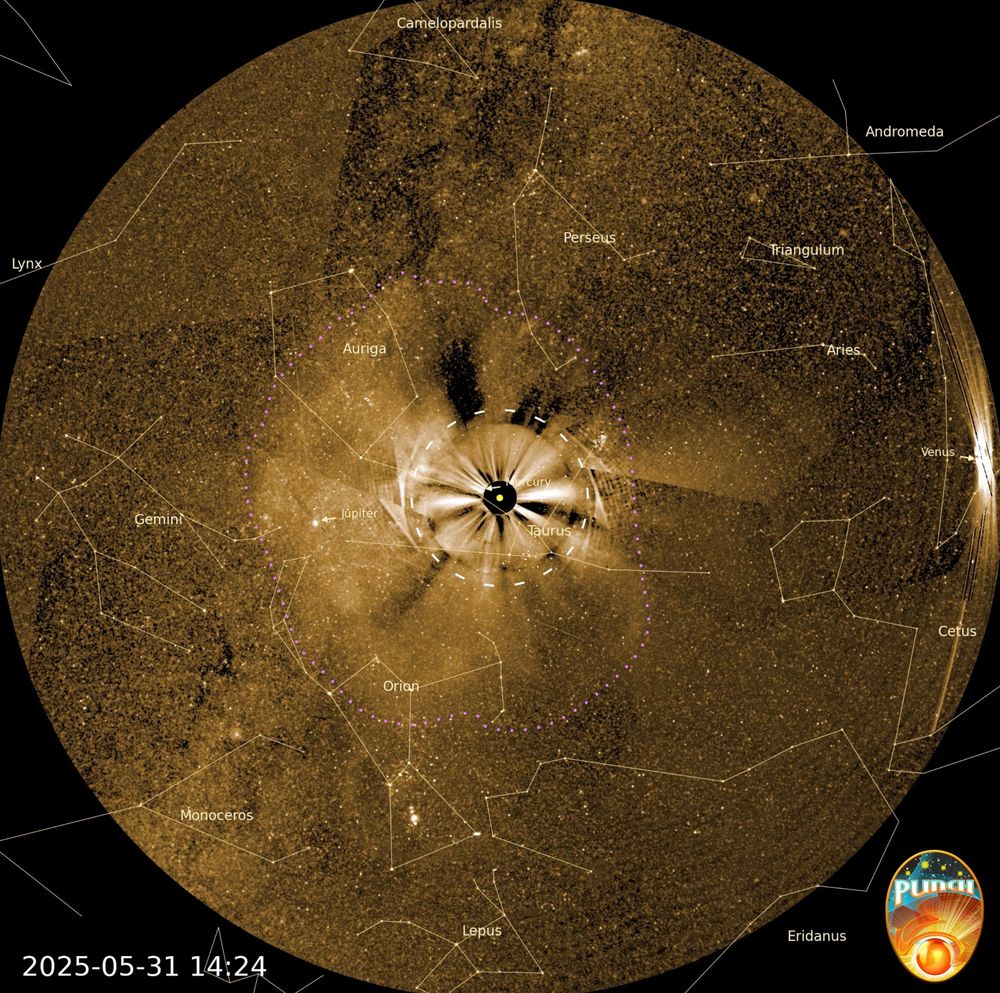
Hey! Lookie what PUNCH (@punch-mission.bsky.social) just saw! Two different solar storms crossing the entire inner solar system! NASA's site doesn't thumbnail well, so click the link for the movie and other images. ☀️🔭🛰️🧪
science.nasa.gov/blogs/punch/...
11.06.2025 01:58 — 👍 86 🔁 24 💬 4 📌 6
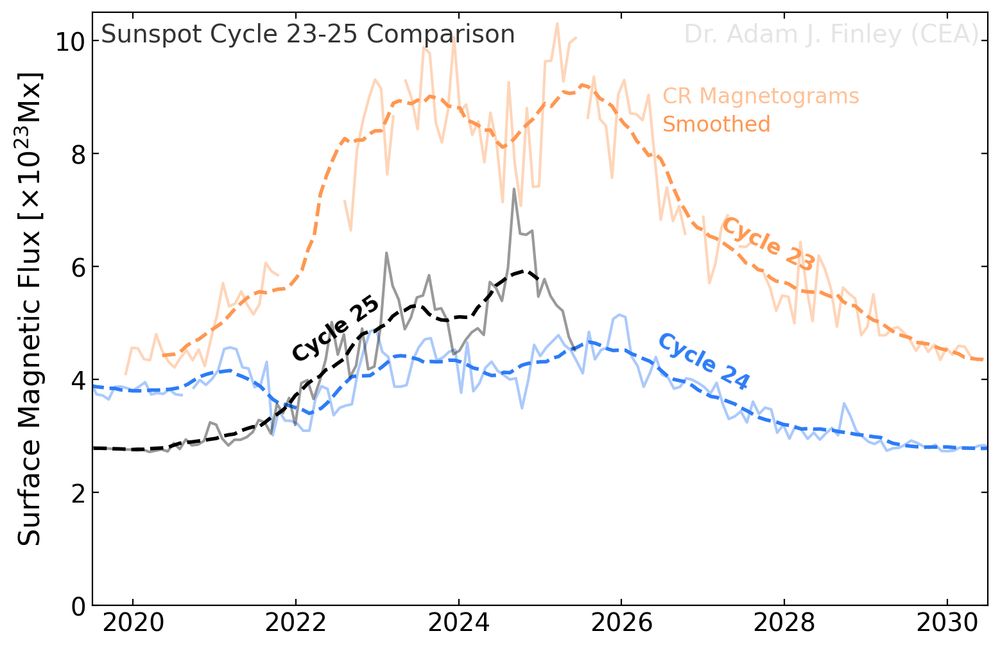
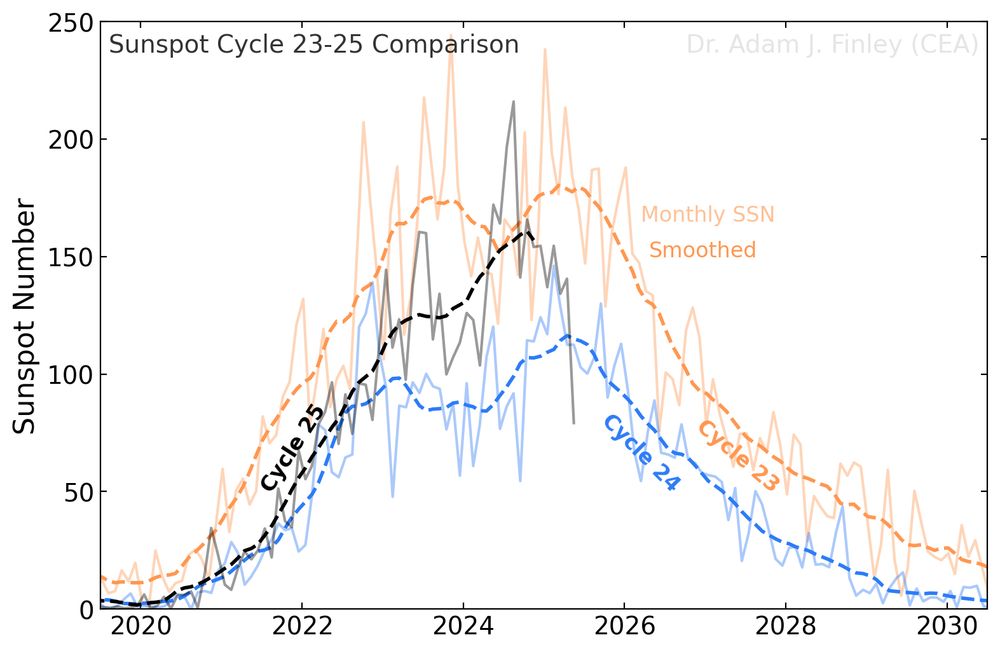
Similarly, the total surface magnetic flux (computed from Carrington maps of the Sun's photospheric magnetic field) is moving back down towards cycle 24. Even at the peak of cycle 25, we were far short of the unsigned magnetic flux from cycle 23! Monthly sunspot number dropped right off in May!
04.06.2025 11:38 — 👍 8 🔁 2 💬 0 📌 0


Similarly, the total surface magnetic flux (computed from Carrington maps of the Sun's photospheric magnetic field) is moving back down towards cycle 24. Even at the peak of cycle 25, we were far short of the unsigned magnetic flux from cycle 23! Monthly sunspot number dropped right off in May!
04.06.2025 11:38 — 👍 8 🔁 2 💬 0 📌 0
There's a fast CME heading into some fast solar wind and some pre-existing slower CMEs. We're currently putting arrival at noon-to-midnight tomorrow, but this forecast may change as more observations become available.
Updates here: research.reading.ac.uk/met-spate/hu...
31.05.2025 07:04 — 👍 88 🔁 24 💬 7 📌 9
En 2022, une zone active est apparue sur le Soleil et a dominé l'activité solaire pendant plusieurs mois.
La mission Solar Orbiter de l' @esa.int a permis une meilleure compréhension de la formation, de l'évolution et des caractéristiques de cette zones actives, essentielle pour la météo spatiale :
28.05.2025 11:53 — 👍 16 🔁 4 💬 1 📌 0
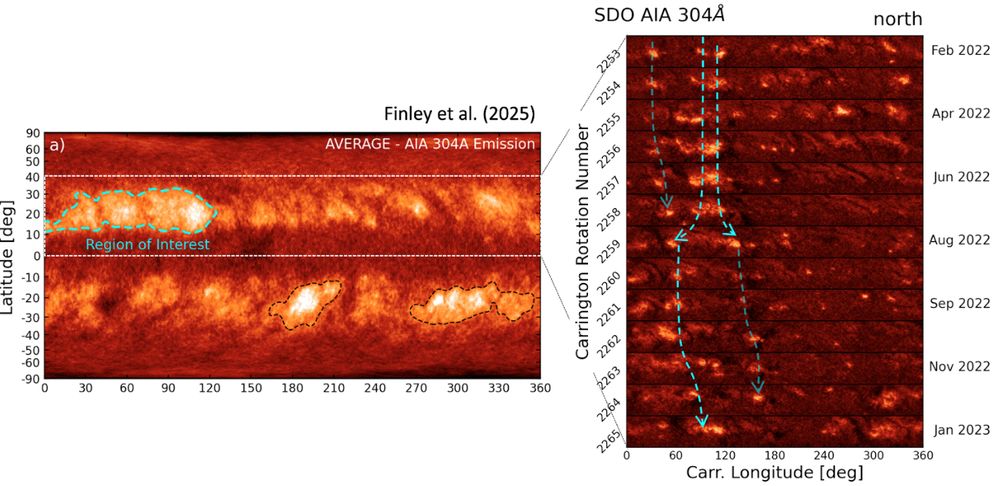
Solar Orbiter Nugget @science.esa.int about our recent active region nest study. We used Solar Orbiter as a far side observer from April to October 2022 to survey magnetic activity over the entire solar surface. This shed light on the nesting of active regions: www.cosmos.esa.int/web/solar-or...
28.05.2025 11:41 — 👍 6 🔁 0 💬 0 📌 1
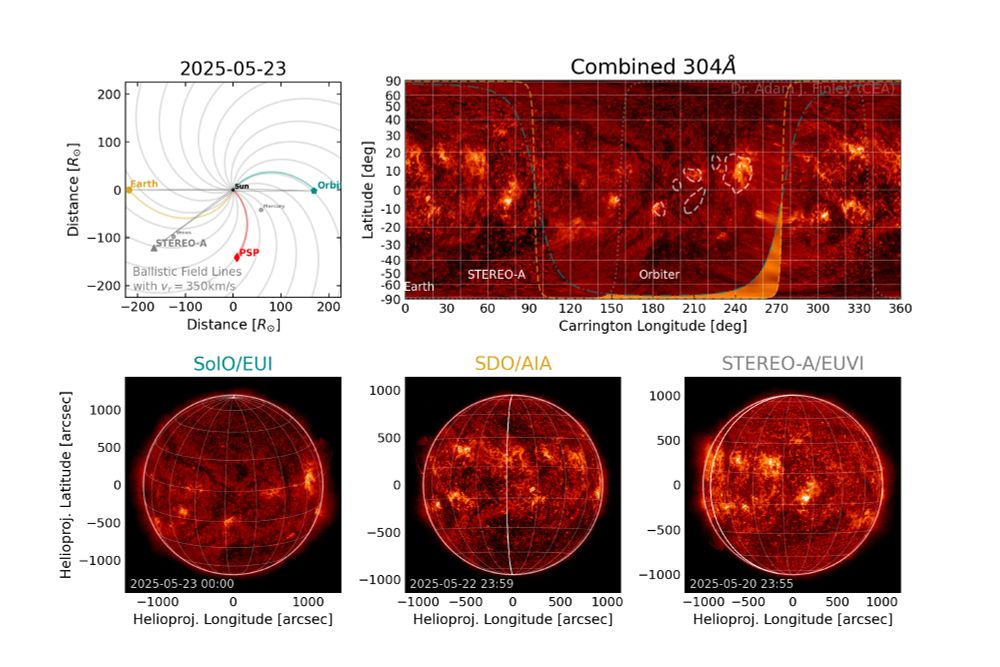
One Carrington rotation later (27 days) and AR14055 is rotating back into view again! Born on the 8th April, this region experienced nested flux emergence that sustained flaring activity for now over a month and a half. Will it continue to be active or begin to die away? @esa.int #heliophysics
23.05.2025 14:30 — 👍 0 🔁 0 💬 0 📌 0
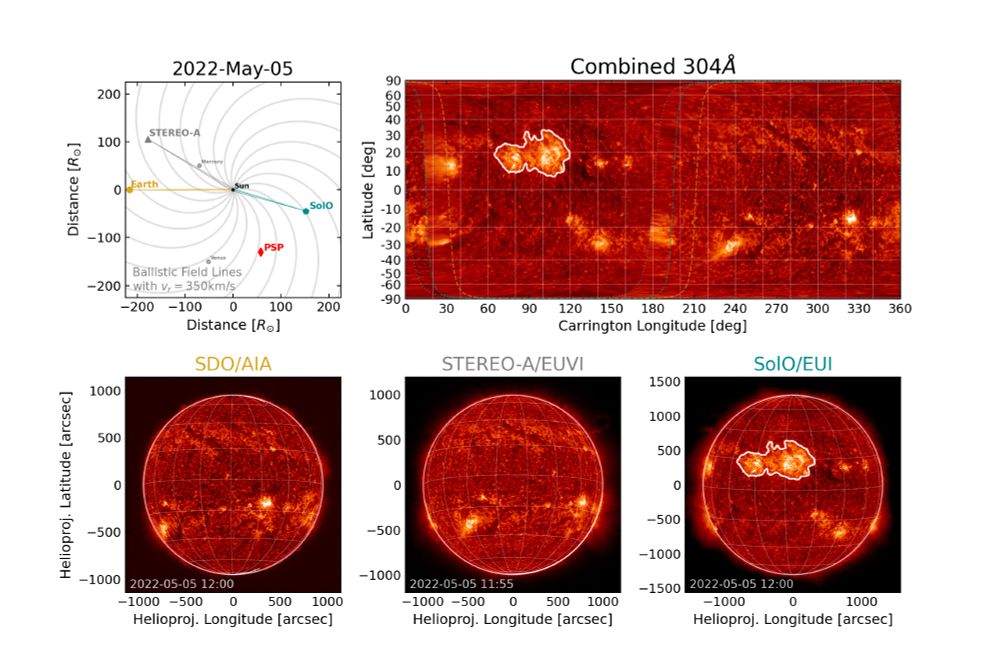
Our latest paper investigating a solar active region nest (prolific flare factory) using near-continuous observations from NASA SDO, @noaa.gov GOES, and @esa.int Solar Orbiter is now published in A&A 🥳:
doi.org/10.1051/0004...
22.05.2025 10:06 — 👍 3 🔁 0 💬 0 📌 0
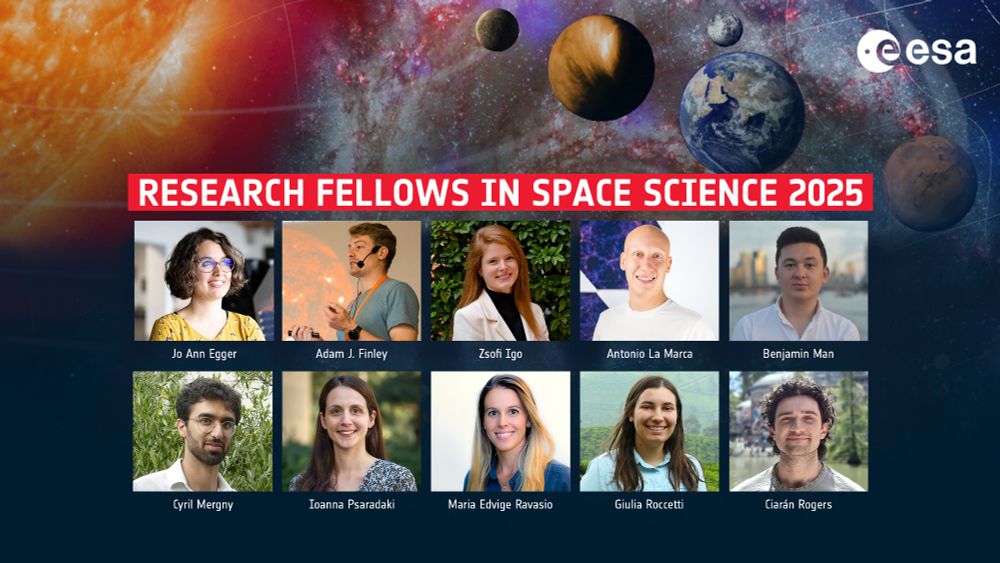
Graphic with space-y background, a title 'Research Fellows in space science 2025' and photos of the 10 new Research Fellows in Space Science 2025 with their names: Jo Ann Egger, Adam J. Finley, Zsofi Igo, Antonio La Marca, Benjamin Man, Cyril Mergny, Ioanna Psaradaki, Maria Edvige Ravasio, Giulia Roccetti and Ciarán Rogers.
Meet the 2025 Research Fellows in space science!
They were selected to pursue their own independent research in space science at one of our establishments.
Find out who they are and what kind of research they do here 👉 www.esa.int/ESA_Multimed...
Congratulations to all!
🧪☄️
07.05.2025 08:00 — 👍 42 🔁 12 💬 1 📌 2
This week's summary, with a much quieter AR14055 rotating back into Earth view (240,10). The Sun is much quieter overall this week with just four M-class events seen by Earth and Solar Orbiter combined (i.e. over the entire solar surface). #heliophysics
02.05.2025 07:43 — 👍 0 🔁 0 💬 1 📌 0
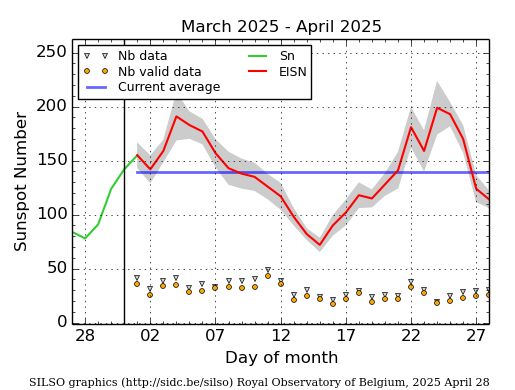
This full-Sun view also highlights the longitudinal variation of solar activity, which has been clear in the sunspot number observations for the past few solar rotations. Solar Orbiter is currently viewing the quieter side of the Sun.
28.04.2025 14:00 — 👍 0 🔁 0 💬 1 📌 0
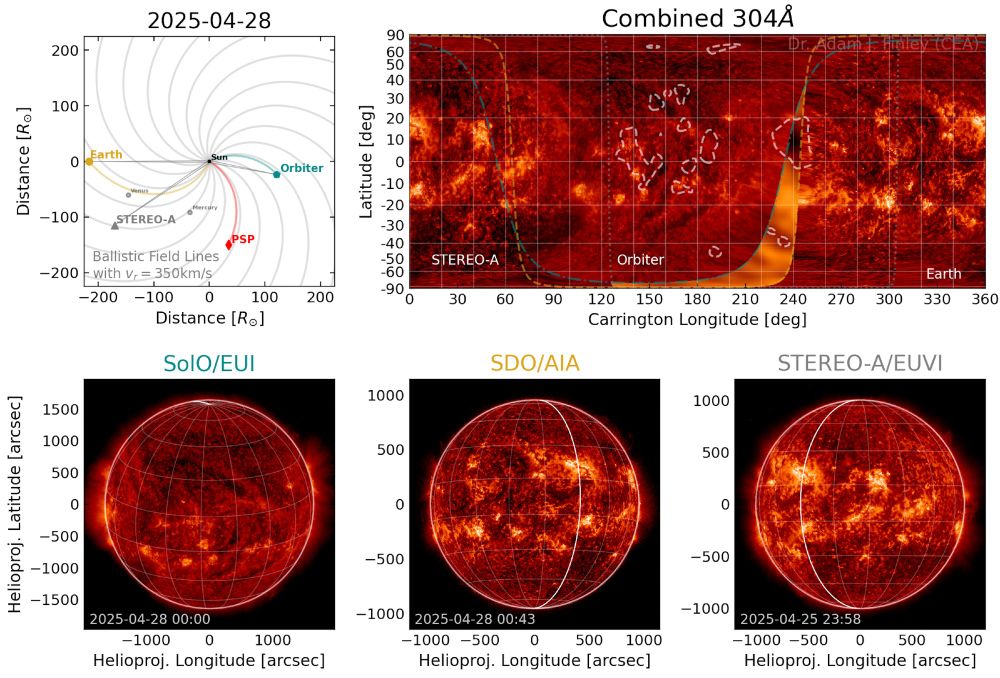
With @esa.int Solar Orbiter back to the Sun's far side, we are again tracking active region over ~ 4pi steradians (note: Orbiter's inclination). We have been able to track AR14055 since it left Earth view on the 15th April (now at the east-limb). AR14055 was producing M-class flares on the far side.
28.04.2025 14:00 — 👍 1 🔁 0 💬 1 📌 0
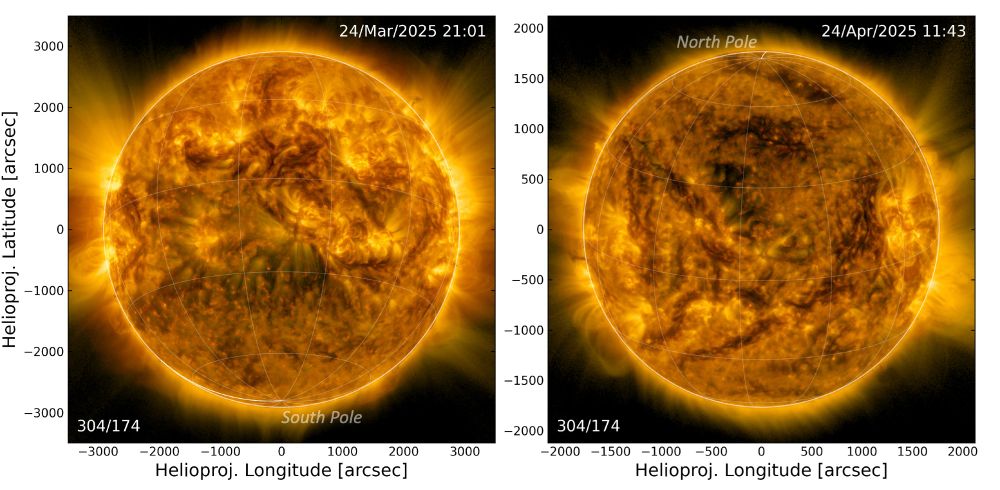
Shifting perspective on the Sun provided by @esa.int Solar Orbiter on its inclined orbit. Low-latency images from the EUI telescope from around perihelion last month to now. 😍
25.04.2025 13:15 — 👍 15 🔁 2 💬 1 📌 0
French astronomer in Sicily 🌋☀️
Osservatorio Astrofisico di Catania | Stellar physics and related stuff ⭐🔭 | I like all types of waves 🌊🔊
Little too much of a railway enthusiast for someone living on an island 🚂
Occasionally under water 🤿🐟
The 33rd @royalastrosoc.bsky.social National Astronomy Meeting is coming to @durham-university.bsky.social hosted by the CEA, CfAI, ICC, IPPP and Maths 🔭🪐 7th - 11th July 2025 ☀️ #NAM2025
https://linktr.ee/NAM_2025
Understanding CMEs and Solar Wind |
Postdoctoral Researcher at Austrian Space Weather Office
DPhil student at the University of Oxford. A stellar physicist pretending to be an exoplanet finder 🌟🪐🌟
Compte officiel de la Société Française d'Astronomie et d'Astrophysique
A solar scientist and the ESA Vigil Mission Scientist, interested in the extended solar atmosphere. I also dabble in a bit of art and outreach
Sharing the excitement of real-time mission operations at the European Space Agency. Home for ESA's teams working on Planetary Defence, Space Weather, Clean Space & Space Debris.
esa.int/Operations
esa.int/Space_Safety
Four spacecraft, one instrument … imaging almost nothing at all.
PUNCH is a polarizing wide-field imager, distributed across four
orbiting spacecraft, to track space weather (and solar wind) across
the heliosphere. (Non-NASA account for the mission team).
PhD Student at Austrian Space Weather Office ☀️🪐🚀
Space Weather, Heliophysics and AI Enthusiast 💻🔭🛰️📊
https://hruedisser.github.io
Space Weather Research Fellow at Surrey Space Centre.
Aviation radiation safety. Instrument systems engineering.
Hobby wargamer and Ipswich Town #itfc fan. He/Him. PhD
Official Consortium of ESA's Euclid mission on the Universe's dark matter, energy & expansion, 15 European countries + USA + CAN + JAP, 2000+ scientists + engineers. Home: https://euclid-ec.org
Aussie 🇦🇺 Solar Physics PhD student @ University of St Andrews
Astro | Helio | Space Weather | ML
Science Director, Space & Astronomy @CSIRO; OMO
Space Scientist, STFC Ermest Rutherford Fellow and Vice-Chancellor's Fellow @ Northumbria University.
stephyardley.com
Heliophysicist interested in solar eruptions and their impacts on the heliosphere
The Laboratory for Atmospheric and Space Physics (LASP) at the University of Colorado Boulder is at the forefront of space weather and climate monitoring, solar and planetary research, and the search for evidence of habitable worlds.
Keeping you posted on space science activities from the European Space Agency.
Web: http://www.esa.int/science
Privacy Notice: esa.int/connectwithus
#astronomy #space #science
studying the sun | university of colorado boulder | davidson college | she/ella
Acteur majeur de la recherche 🇫🇷 et 🇪🇺
Apporte des solutions technologiques concrètes 💪
#Énergie #Climat #Numérique #Santé #Défense #Sécurité





























